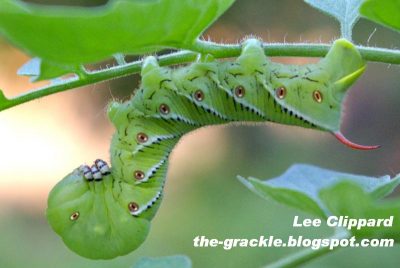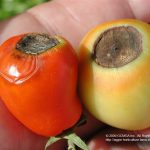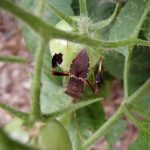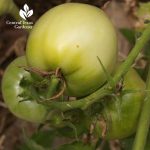Tomato pests and problems

Everyone loves a fresh red ripe tomato fresh from the garden. Unfortunately so do many insects! Here is a guide to some of the more common insect and cultural problems that you may encounter when growing tomatoes.
- Blossom End Rot occurs when soil moisture fluctuates dramatically. Calcium may be in the soil at adequate levels, but moisture fluctuations make it unavailable to the plant as Calcium moves very slowly in plant tissues. Blossom end rot occurs on the bottom of the tomato, on the blossom end, and the skin turns black and fails to grow. It may appear on green tomatoes and ripening ones.
- Gypsum may be added if calcium is low (rare in Austin soils) or you may fertilize with chopped comfrey leaves and crushed egg shells. Foliar sprays with seaweed may help if the problem persists. Mulch can help moderate moisture, but don’t place mulch close to plant stems.
- Remove all affected fruit and discard. Don’t stress the plant by maturing undesirable fruit.
- Too much nitrogen or magnesium fertilizer can also contribute.
- Similar looking black spots on areas other than the bottom of the fruit are probably Early Blight.
- Cracking and catfacing can also be a result of inconsistent watering and too much nitrogen. A tomato will achieve a certain size and the skin hardens. If the plants are then watered heavily, the skin expands and breaks like a stretch mark. The affected parts can be cut away and the fruit may be consumed. The cracks may be in concentric rings around the top of a tomato or along the sides from stem to blossom end. High nitrogen levels can lead to double blooms, which then develop distorted fruit.
- Leaves that have disappeared, leaving bare stems are probably the work of the hornworm caterpillar. Look for black droppings, and handpick the large green caterpillars. They have a curved hook on their tail but it is not harmful. Avoid removal of worms with white cocoons; these are the cocoons of a beneficial wasp, the braconid wasp. The worm stops eating as it is being devoured by these tiny parasites.
- Downward curling leaves or puckered leaves are usually the result of aphid damage. Aphids and other insects can transmit diseases to plants.
- Leaf miners create tunnels in leaves. Pick and destroy affected leaves and treat with Neem oil if the damage is severe.
- Flea beetles leave tiny holes in plant leaves, usually not a problem, but can be controlled with beneficial nematodes.
- Spider mite damage leaves look spotty yellow or bronzed, or may have webbing. Control with them with water blasts, Neem, and seaweed sprays. Infestations of mites are common in drought stressed plants. Provide shade to plants when daytime temperatures get above 95 degrees.
- Stink bugs can cause dimpling and sunken spots on tomato fruit. Their damage stresses plants and affects the flavor of fruit. Handpick the adults or use a shop vac to remove them. Spray the foliage of plants in the evening to cool the bugs down and use gloved hands or a chopstick to knock the bugs into a container of soapy water to drown. Insect’s metabolism increases in heat and they move faster when it is hot, so do this style of pest control late at night or in the early morning. I use Cardoon and sunflowers as trap crops to control stink bugs. They are easier to spot and manage on that foliage. Asparagus ferns also attract the stink bugs and the nymphs are easy to dispatch in the asparagus bed. The nymph stages of stinkbugs do not fly, so they are easier targets than the adult fliers. They also tend to congregate in groups. Make sure you can identify them larval stage of these enemy insects!
- Whiteflies on tomatoes can indicate a Nitrogen deficiency. Use insecticidal soap or Neem to control them and invite ladybugs and other beneficial insects to assist in the control of whiteflies. They are seldom a problem in well managed organic programs
categories:
tags:

 Trisha Shirey
Trisha Shirey Tomato disease
Tomato disease Tomato List
Tomato List Tomato Problems
Tomato Problems Tomatoes Planting and Growing Tips
Tomatoes Planting and Growing Tips